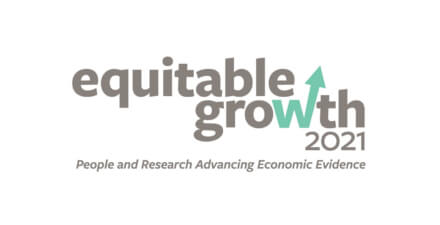NBER Summer Institute 2021 Round-up: Week 2

On July 12, the National Bureau of Economic Research kicked off its summer institute, an annual 3-week conference featuring discussions and paper presentations on specific subfields of economics, including wealth taxation and tax evasion, market structure and competition, and labor market inequalities. This year’s NBER event is being held virtually due to the coronavirus pandemic and is being livestreamed on YouTube.
We’re excited to see Equitable Growth’s grantee network, Steering Committee, and Research Advisory Board and their research well-represented throughout the program. Below are abstracts (in no particular order) of some of the papers that caught the attention of Equitable Growth staff during the second week of the conference. Click here for a round-up from week 1, and come back on Monday, August 2 for highlights from the third and final week of sessions and presentations.
“Skills, Degrees, and Labor Market Inequality”
Peter Blair, Harvard University, NBER, Equitable Growth grantee
Papia Debroy, Opportunity@Work
Justin Heck, University of Michigan
Abstract: Over the past four decades, income inequality grew significantly between workers with bachelor’s degrees and those with high school diplomas (often called “unskilled”). Rather than being unskilled, we argue that these workers are STARs because they are skilled through alternative routes—namely, their work experience. Using the skill requirements of a worker’s current job as a proxy of their skill, we find that though both groups of workers make transitions to occupations requiring similar skills to their previous occupations, workers with bachelor’s degrees have dramatically better access to higher-wage occupations where the skill requirements exceed the workers’ observed skill. This measured opportunity gap offers a fresh explanation of income inequality by degree status and reestablishes the important role of on-the-job-training in human capital formation.
“Spending and Job Search Impacts of Expanded Unemployment Benefits: Evidence from Administrative Micro Data”
Peter Ganong, University of Chicago, NBER, Equitable Growth grantee
Fiona Greig, JPMorgan Chase Institute
Max Liebeskind, Nyca Partners
Pascal Noel, University of Chicago, NBER, Equitable Growth grantee
Daniel M. Sullivan, JPMorgan Chase Institute
Joseph S. Vavra, University of Chicago, NBER
Abstract: How did the largest expansion of unemployment benefits in U.S. history affect household behavior? Using anonymized bank account data covering millions of households, we provide new empirical evidence on the spending and job search responses to benefit changes during the pandemic and compare those responses to the predictions of benchmark structural models. We find that spending responds more than predicted, while job search responds an order of magnitude less than predicted. In sharp contrast to normal times, when spending falls after job loss, we show that when expanded benefits are available, spending of the unemployed actually rises after job loss. Using quasi-experimental research designs, we estimate a large marginal propensity to consume out of benefits. Notably, spending responses are large even for households who have built up substantial liquidity through prior receipt of expanded benefits. These large responses contrast with a theoretical prediction that spending responses should shrink with liquidity. Simple job search models predict a sharp decline in search in the wake of a substantial benefit expansion, followed by a sustained rebound when benefits expire. We instead find that the job finding rate is quite stable. Moreover, we document that recall plays an important role in driving job-finding dynamics throughout the pandemic. A model extended to fit these key features of the data implies small job search distortions from expanded unemployment benefits. Jointly, these spending and job finding facts suggest that benefit expansions during the pandemic were a more effective policy than predicted by standard structural models. Abstracting from general equilibrium effects, we find that overall spending was 2 percent to 2.6 percent higher and employment only 0.2 percent to 0.4 percent lower as a result of the benefit expansions.
“Structural Transformation and U-Shaped Female Employment”
Rachel L. Ngai, London School of Economics, CEPR
Claudia Olivetti, Dartmouth College, NBER
Barbara Petrongolo, University of Oxford
Abstract: We build a consistent measure of female employment for the United States over the past 150 years—encompassing intensive and extensive margins—combining data from the U.S. population census and several early state-level surveys on various personal and economic circumstances of individuals. The resulting measure of employment—which includes paid work, as well as unpaid work in family business and corrects for other sources of underreporting—displays a U shape over time. We empirically and theoretically relate the U-shaped labor supply to the process of structural transformation and, namely, the reallocation of labor from female-intensive agriculture into male-intensive manufacturing at early stages of development and from manufacturing into female-intensive services at later stages. We propose a multisector model of the economy, where the interplay between uneven productivity growth and consumption complementarities across sectors predicts the modernization of agriculture and decline of family farms, the rise in manufacturing and services, and the marketization of home production. The downward portion of the U-shaped pattern is associated with the decline in agricultural employment and the disappearance of the family farm, while the upward portion is driven by the expansion of the service economy, to the detriment of manufacturing, and the marketization of home production.
Note: This abstract is from an earlier version of this paper. For updated details, please click here.
“Common Ownership, Competition, and Top Management Incentive”
Miguel Antón, IESE Business School
Florian Ederer, Yale University
Mireia Giné, IESE Business School
Martin Schmalz, University of Oxford
Abstract: We present a mechanism based on managerial incentives through which common ownership affects product market outcomes. Firm-level variation in common ownership causes variation in managerial incentives and productivity across firms, which leads to intra-industry and intra-firm cross-market variation in prices, output, mark-ups, and market shares that is consistent with empirical evidence. The organizational structure of multiproduct firms and the passivity of common owners determine whether higher prices under common ownership result from higher costs or from higher mark-ups. Using panel regressions and a difference-in-differences design, we document that managerial incentives are less performance-sensitive in firms with more common ownership.
“Tax Evasion at the Top of the Income Distribution: Theory and Evidence”
John Guyton, Internal Revenue Service
Patrick Langetieg, Internal Revenue Service
Daniel Reck, London School of Economics, Equitable Growth grantee
Max Risch, Carnegie Mellon University, Equitable Growth grantee
Gabriel Zucman, University of California, Berkeley, NBER, Equitable Growth grantee
Abstract: This paper studies tax evasion at the top of the U.S. income distribution using IRS microdata from random audits, targeted enforcement activities, and operational audits. Drawing on this unique combination of data, we demonstrate empirically that random audits underestimate tax evasion at the top of the income distribution. Specifically, random audits do not capture most tax evasion through offshore accounts and pass-through businesses, both of which are quantitatively important at the top. We provide a theoretical explanation for this phenomenon, and we construct new estimates of the size and distribution of tax noncompliance in the United States. In our model, individuals can adopt a technology that would better conceal evasion at some fixed cost. Risk preferences and relatively high audit rates at the top drive the adoption of such sophisticated evasion technologies by high-income individuals. Consequently, random audits, which do not detect most sophisticated evasion, underestimate top tax evasion. After correcting for this bias, we find that unreported income as a fraction of true income rises from 7 percent in the bottom 50 percent to more than 20 percent in the top 1 percent, of which 6 percentage points correspond to undetected sophisticated evasion. Accounting for tax evasion increases the top 1 percent fiscal income share significantly.
Note: This paper was funded in part by Equitable Growth.
“The Impact of Criminal Records on Employment, Earnings, and Tax Outcomes”
Amanda Agan, Rutgers University, NBER
Andrew Garin, University of Illinois at Urbana-Champaign
Dmitri Koustas, University of Chicago
Alexandre Mas, Princeton University, NBER, Equitable Growth grantee
Crystal Yang, Harvard University, NBER
Abstract: This paper adds to the empirical evidence that criminal records are a barrier to employment. Using data from 2,655 online applications sent on behalf of fictitious male applicants, we show that employers are 60 percent more likely to call applicants that do not have a felony conviction. We further investigate whether this effect varies based on applicant race (Black versus White), crime type (drug versus property crime), industry (restaurants versus retail), jurisdiction (New Jersey versus New York City), local crime rate, and local racial composition. Although magnitudes vary somewhat, in every subsample, the conviction effect is large, significant, and negative.
Note: This abstract is from an earlier version of this paper, which featured fewer authors alongside Agan.
“Efficiency Gains from Wealth Taxation: A Theoretical Analysis”
Fatih Guvenen, University of Minnesota, NBER, Equitable Growth grantee
Gueorgui Kambourov, University of Toronto
Burhanettin Kuruscu, University of Toronto
Sergio Ocampo-Diaz, Western University (Canada)
Abstract: How does wealth taxation differ from capital income taxation? When the return on investment is equal across individuals, a well-known result is that the two tax systems are equivalent. Motivated by recent empirical evidence documenting persistent heterogeneity in rates of return across individuals, we revisit this question. With such heterogeneity, the two tax systems have opposite implications for both efficiency and inequality. Under capital income taxation, entrepreneurs who are more productive, and therefore generate more income, pay higher taxes. Under wealth taxation, entrepreneurs who have similar wealth levels pay similar taxes regardless of their productivity, which expands the tax base, shifts the tax burden toward unproductive entrepreneurs, and raises the savings rate of productive ones. This reallocation increases aggregate productivity and output. In the simulated model parameterized to match the U.S. data, replacing the capital income tax with a wealth tax in a revenue-neutral fashion delivers a significantly higher average lifetime utility to a newborn (about 7.5 percent in consumption-equivalent terms). Turning to optimal taxation, the optimal wealth tax, or OWT, in a stationary equilibrium is positive and yields even larger welfare gains. In contrast, the optimal capital income tax, or OCIT, is negative—a subsidy—and large, and it delivers lower welfare gains than the wealth tax. Furthermore, the subsidy policy increases consumption inequality, whereas the wealth tax reduces it slightly. We also consider an extension that models the transition path and find that individuals who are alive at the time of the policy change, on average, would incur large welfare losses if the new policy is OCIT but would experience large welfare gains if the new policy is an OWT. We conclude that wealth taxation has the potential to raise productivity while simultaneously reducing consumption inequality.
Note: This abstract is from an earlier version of this paper. For updated details, please click here.
“Unbundling Labor”
Chris Edmond, University of Melbourne
Simon Mongey, University of Chicago, NBER, Equitable Growth grantee
Abstract: In this paper, we provide a theory for the role of technological change in the relative substitutability of workers in the economy. We show the theory to be useful for understanding new trends that we identify in the wages paid to workers. We extend Rosen (1983) to study when the bundled talents of workers that define their comparative advantage leads them to earn rents, and when these talents may be unbundled such that workers are more substitutable and rents are competed away. Allowing firms to choose their technology, as in Caselli and Coleman (2006), endogenizes this substitutability. When technologies are adapted to labor supply, an unbundled economy is more likely, rents to workers shrink, and workers get paid more similarly. We provide empirical evidence consistent with the theory. In the United States, workers in low-skill occupations are paid more similarly now than in the 1980s. Over-time premia, part-time penalties, and experience premia have disappeared.
Note: This abstract is from an earlier version of this paper. For updated details, please click here.






